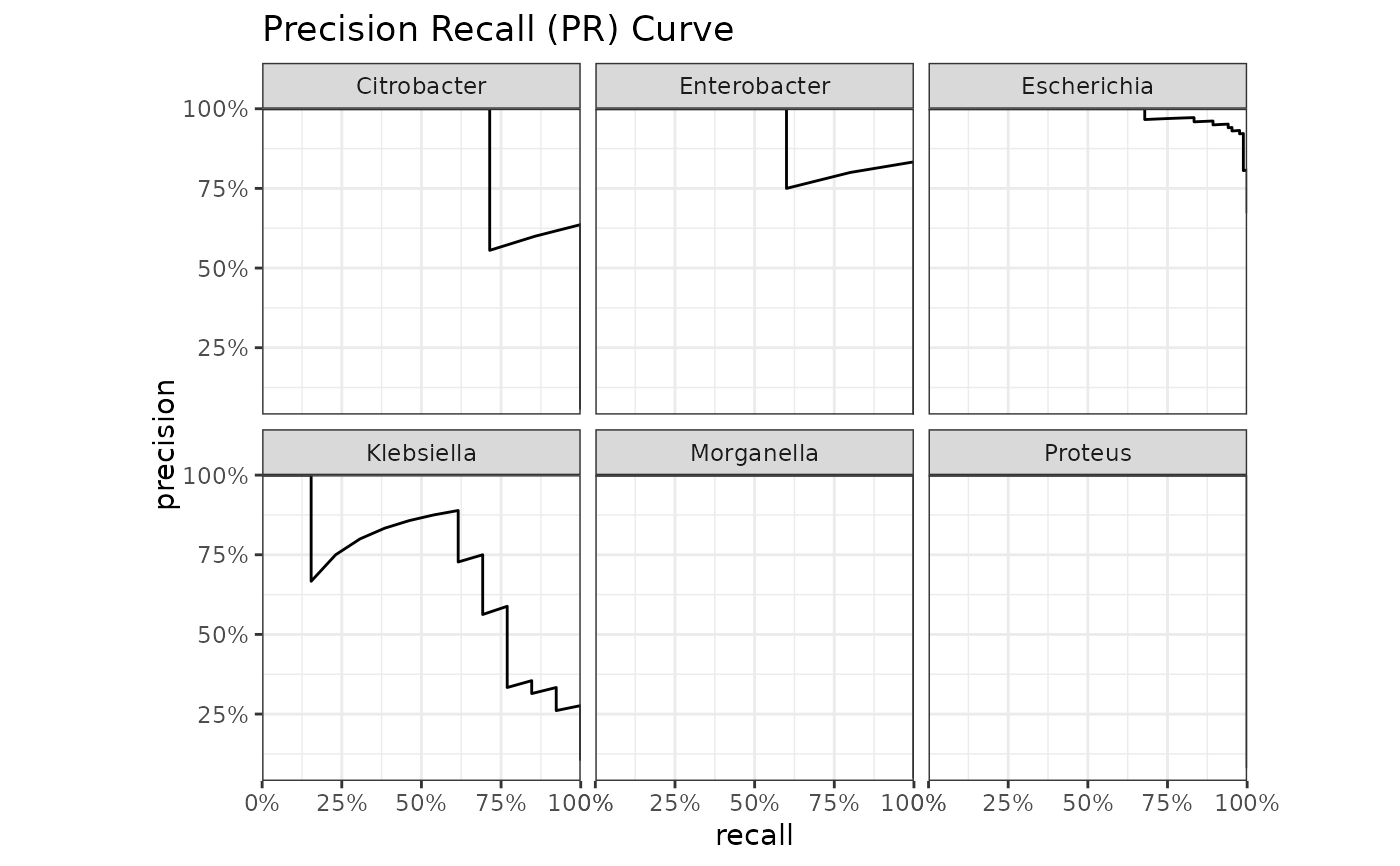These functions can be used to create a machine learning model based on different 'engines' and to generalise predicting outcomes based on such models. These functions are wrappers around tidymodels packages (especially parsnip, recipes, rsample, tune, and yardstick) created by RStudio.
ml_xg_boost(
.data,
outcome,
predictors = everything(),
training_fraction = 0.75,
strata = NULL,
na_threshold = 0.01,
correlation_threshold = 0.9,
centre = TRUE,
scale = TRUE,
engine = "xgboost",
mode = c("classification", "regression", "unknown"),
trees = 15,
...
)
ml_decision_trees(
.data,
outcome,
predictors = everything(),
training_fraction = 0.75,
strata = NULL,
na_threshold = 0.01,
correlation_threshold = 0.9,
centre = TRUE,
scale = TRUE,
engine = "rpart",
mode = c("classification", "regression", "unknown"),
tree_depth = 30,
...
)
ml_random_forest(
.data,
outcome,
predictors = everything(),
training_fraction = 0.75,
strata = NULL,
na_threshold = 0.01,
correlation_threshold = 0.9,
centre = TRUE,
scale = TRUE,
engine = "ranger",
mode = c("classification", "regression", "unknown"),
trees = 500,
...
)
ml_neural_network(
.data,
outcome,
predictors = everything(),
training_fraction = 0.75,
strata = NULL,
na_threshold = 0.01,
correlation_threshold = 0.9,
centre = TRUE,
scale = TRUE,
engine = "nnet",
mode = c("classification", "regression", "unknown"),
penalty = 0,
epochs = 100,
...
)
ml_nearest_neighbour(
.data,
outcome,
predictors = everything(),
training_fraction = 0.75,
strata = NULL,
na_threshold = 0.01,
correlation_threshold = 0.9,
centre = TRUE,
scale = TRUE,
engine = "kknn",
mode = c("classification", "regression", "unknown"),
neighbors = 5,
weight_func = "triangular",
...
)
ml_linear_regression(
.data,
outcome,
predictors = everything(),
training_fraction = 0.75,
strata = NULL,
na_threshold = 0.01,
correlation_threshold = 0.9,
centre = TRUE,
scale = TRUE,
engine = "lm",
mode = "regression",
...
)
ml_logistic_regression(
.data,
outcome,
predictors = everything(),
training_fraction = 0.75,
strata = NULL,
na_threshold = 0.01,
correlation_threshold = 0.9,
centre = TRUE,
scale = TRUE,
engine = "glm",
mode = "classification",
penalty = 0.1,
...
)
# S3 method for class 'certestats_ml'
confusion_matrix(data, ...)
# S3 method for class 'certestats_ml'
predict(object, new_data, type = NULL, ...)
apply_model_to(
object,
new_data,
only_prediction = FALSE,
only_certainty = FALSE,
correct_mistakes = TRUE,
impute_algorithm = "mice",
...
)
feature_importances(object, ...)
feature_importance_plot(object, ...)
roc_plot(object, ...)
gain_plot(object, ...)
tree_plot(object, ...)
correlation_plot(
data,
add_values = TRUE,
cols = everything(),
correlation_threshold = 0.9
)
get_metrics(object)
get_accuracy(object)
get_kappa(object)
get_recipe(object)
get_specification(object)
get_rows_testing(object)
get_rows_training(object)
get_original_data(object)
get_roc_data(object)
get_coefficients(object)
get_model_variables(object)
get_variable_weights(object)
tune_parameters(object, ..., only_params_in_model = FALSE, levels = 5, k = 10)
check_testing_predictions(object)
# S3 method for class 'certestats_ml'
autoplot(object, plot_type = "roc", ...)
# S3 method for class 'certestats_feature_importances'
autoplot(object, ...)
# S3 method for class 'certestats_tuning'
autoplot(object, type = c("marginals", "parameters", "performance"), ...)Arguments
- .data
Data set to train
- outcome
Outcome variable, also called the response variable or the dependent variable; the variable that must be predicted. The value will be evaluated in
select()and thus supports thetidyselectlanguage. In case of classification prediction, this variable will be coerced to a factor.- predictors
Explanatory variables, also called the predictors or the independent variables; the variables that are used to predict
outcome. These variables will be transformed usingas.double()(factors will be transformed to characters first). This value defaults toeverything()and supports thetidyselectlanguage.- training_fraction
Fraction of rows to be used for training, defaults to 75%. The rest will be used for testing. If given a number over 1, the number will be considered to be the required number of rows for training.
- strata
A variable in
data(single character or name) used to conduct stratified sampling. When notNULL, each resample is created within the stratification variable. Numericstrataare binned into quartiles.- na_threshold
Maximum fraction of
NAvalues (defaults to0.01) of thepredictorsbefore they are removed from the model, usingrecipes::step_rm()- correlation_threshold
A value (default 0.9) to indicate the correlation threshold. Predictors with a correlation higher than this value with be removed from the model, using
recipes::step_corr()- centre
A logical to indicate whether the
predictorsshould be transformed so that their mean will be0, usingrecipes::step_center(). Binary columns will be skipped.- scale
A logical to indicate whether the
predictorsshould be transformed so that their standard deviation will be1, usingrecipes::step_scale(). Binary columns will be skipped.- engine
R package or function name to be used for the model, will be passed on to
parsnip::set_engine()- mode
Type of predicted value - defaults to
"classification", but can also be"unknown"or"regression"- trees
An integer for the number of trees contained in the ensemble.
- ...
Arguments to be passed on to the
parsnipfunctions, see Model Functions.For the
tune_parameters()function, these must bedialspackage calls, such asdials::trees()(see Examples).For
predict(), these must be arguments passed on toparsnip::predict.model_fit()- tree_depth
An integer for maximum depth of the tree.
- penalty
A non-negative number representing the total amount of regularization (specific engines only).
- epochs
An integer for the number of training iterations.
- neighbors
A single integer for the number of neighbors to consider (often called
k). For kknn, a value of 5 is used ifneighborsis not specified.- weight_func
A single character for the type of kernel function used to weight distances between samples. Valid choices are:
"rectangular","triangular","epanechnikov","biweight","triweight","cos","inv","gaussian","rank", or"optimal".- object, data
outcome of machine learning model
- new_data
A rectangular data object, such as a data frame.
- type
A single character value or
NULL. Possible values are"numeric","class","prob","conf_int","pred_int","quantile","time","hazard","survival", or"raw". WhenNULL,predict()will choose an appropriate value based on the model's mode.- only_prediction
a logical to indicate whether predictions must be returned as vector, otherwise returns a data.frame
- only_certainty
a logical to indicate whether certainties must be returned as vector, otherwise returns a data.frame
- correct_mistakes
a logical to indicate whether missing variables and missing values should be added to
new_data- impute_algorithm
the algorithm to use in
impute()ifcorrect_mistakes = TRUE. Can be"mice"(default) for the Multivariate Imputations by Chained Equations (MICE) algorithm, or"single-point"for a trained median.- add_values
a logical to indicate whether values must be printed in the tiles
- cols
columns to use for correlation plot, defaults to
everything()- only_params_in_model
a logical to indicate whether only parameters in the model should be tuned
- levels
An integer for the number of values of each parameter to use to make the regular grid.
levelscan be a single integer or a vector of integers that is the same length as the number of parameters in....levelscan be a named integer vector, with names that match the id values of parameters.- k
The number of partitions of the data set
- plot_type
the plot type, can be
"roc"(default),"gain","lift"or"pr". These functions rely onyardstick::roc_curve(),yardstick::gain_curve(),yardstick::lift_curve()andyardstick::pr_curve()to construct the curves.
Value
A machine learning model of class certestats_ml / ... / model_fit.
Details
To predict regression (numeric values), the function ml_logistic_regression() cannot be used.
To predict classifications (character values), the function ml_linear_regression() cannot be used.
The workflow of the ml_*() functions is basically like this (thus saving a lot of tidymodels functions to type):
.data
|
rsample::initial_split()
/ \
rsample::training() rsample::testing()
| |
recipe::recipe() |
| |
recipe::step_corr() |
| |
recipe::step_center() |
| |
recipe::step_scale() |
| |
recipe::prep() |
/ \ |
recipes::bake() recipes::bake()
| |
generics::fit() yardstick::metrics()
| |
output attributes(output)
The predict() function can be used to fit a model on a new data set. Its wrapper apply_model_to() works in the same way, but can also detects and fixes missing variables, missing data points, and data type differences between the trained data and the input data.
Use feature_importances() to get the importance of all features/variables. Use autoplot() afterwards to plot the results. These two functions are combined in feature_importance_plot().
Use correlation_plot() to plot the correlation between all variables, even characters. If the input is a certestats ML model, the training data of the model will be plotted.
Use the get_model_variables() function to return a zero-row data.frame with the variables that were used for training, even before the recipe steps.
Use the get_variable_weights() function to determine the (rough) estimated weights of each variable in the model. This is not as reliable as retrieving coefficients, but it does work for any model. The weights are determined by running the model over all the highest and lowest values of each variable in the trained data. The function returns a data set with 1 row, of which the values sum up to 1.
Use the tune_parameters() function to analyse tune parameters of any ml_*() function. Without any parameters manually defined, it will try to tune all parameters of the underlying ML model. The tuning will be based on a K-fold cross-validation, of which the number of partitions can be set with k. The number of levels will be used to split the range of the parameters. For example, a range of 1-10 with levels = 2 will lead to [1, 10], while levels = 5 will lead to [1, 3, 5, 7, 9]. The resulting data.frame will be sorted from best to worst. These results can also be plotted using autoplot().
The check_testing_predictions() function combines the data used for testing from the original data with its predictions, so the original data can be reviewed per prediction.
Use autoplot() on a model to plot the receiver operating characteristic (ROC) curve, the gain curve, the lift curve, or the precision-recall (PR) curve. For the ROC curve, the (overall) area under the curve (AUC) will be printed as subtitle.
Attributes
The ml_*() functions return the following attributes:
properties: a list with model properties: the ML function, engine package, training size, testing size, strata size, mode, and the different ML function-specific properties (such astree_depthinml_decision_trees())recipe: a recipe as generated withrecipes::prep(), to be used for training and testingdata_original: a data.frame containing the original data, possibly without invalid stratadata_structure: a data.frame containing the original data structure (only trained variables) with zero rowsdata_means: a data.frame containing the means of the original data (only trained variables)data_training: a data.frame containing the training data ofdata_originaldata_testing: a data.frame containing the testing data ofdata_originalrows_training: an integer vector of rows used for training indata_originalrows_testing: an integer vector of rows used for training indata_originalpredictions: a data.frame containing predicted values based on the testing datametrics: a data.frame with model metrics as returned byyardstick::metrics()correlation_threshold: a logical indicating whetherrecipes::step_corr()has been appliedcentre: a logical indicating whetherrecipes::step_center()has been appliedscale: a logical indicating whetherrecipes::step_scale()has been applied
Model Functions
These are the called functions from the parsnip package. Arguments set in ... will be passed on to these parsnip functions:
ml_decision_trees:parsnip::decision_tree()ml_linear_regression:parsnip::linear_reg()ml_logistic_regression:parsnip::logistic_reg()ml_neural_network:parsnip::mlp()ml_nearest_neighbour:parsnip::nearest_neighbor()ml_random_forest:parsnip::rand_forest()ml_xg_boost:parsnip::xgb_train()
Examples
# 'esbl_tests' is an included data set, see ?esbl_tests
print(esbl_tests, n = 5)
#> # A tibble: 500 × 19
#> esbl genus AMC AMP TZP CXM FOX CTX CAZ GEN TOB TMP SXT
#> <lgl> <chr> <dbl> <dbl> <dbl> <dbl> <dbl> <dbl> <dbl> <dbl> <dbl> <dbl> <dbl>
#> 1 FALSE Esche… 32 32 4 64 64 8 8 1 1 16 20
#> 2 FALSE Esche… 32 32 4 64 64 4 8 1 1 16 320
#> 3 FALSE Esche… 4 2 64 8 4 8 0.12 16 16 0.5 20
#> 4 FALSE Klebs… 32 32 16 64 64 8 8 1 1 0.5 20
#> 5 FALSE Esche… 32 32 4 4 4 0.25 2 1 1 16 320
#> # ℹ 495 more rows
#> # ℹ 6 more variables: NIT <dbl>, FOS <dbl>, CIP <dbl>, IPM <dbl>, MEM <dbl>,
#> # COL <dbl>
esbl_tests |> correlation_plot(add_values = FALSE) # red will be removed from model
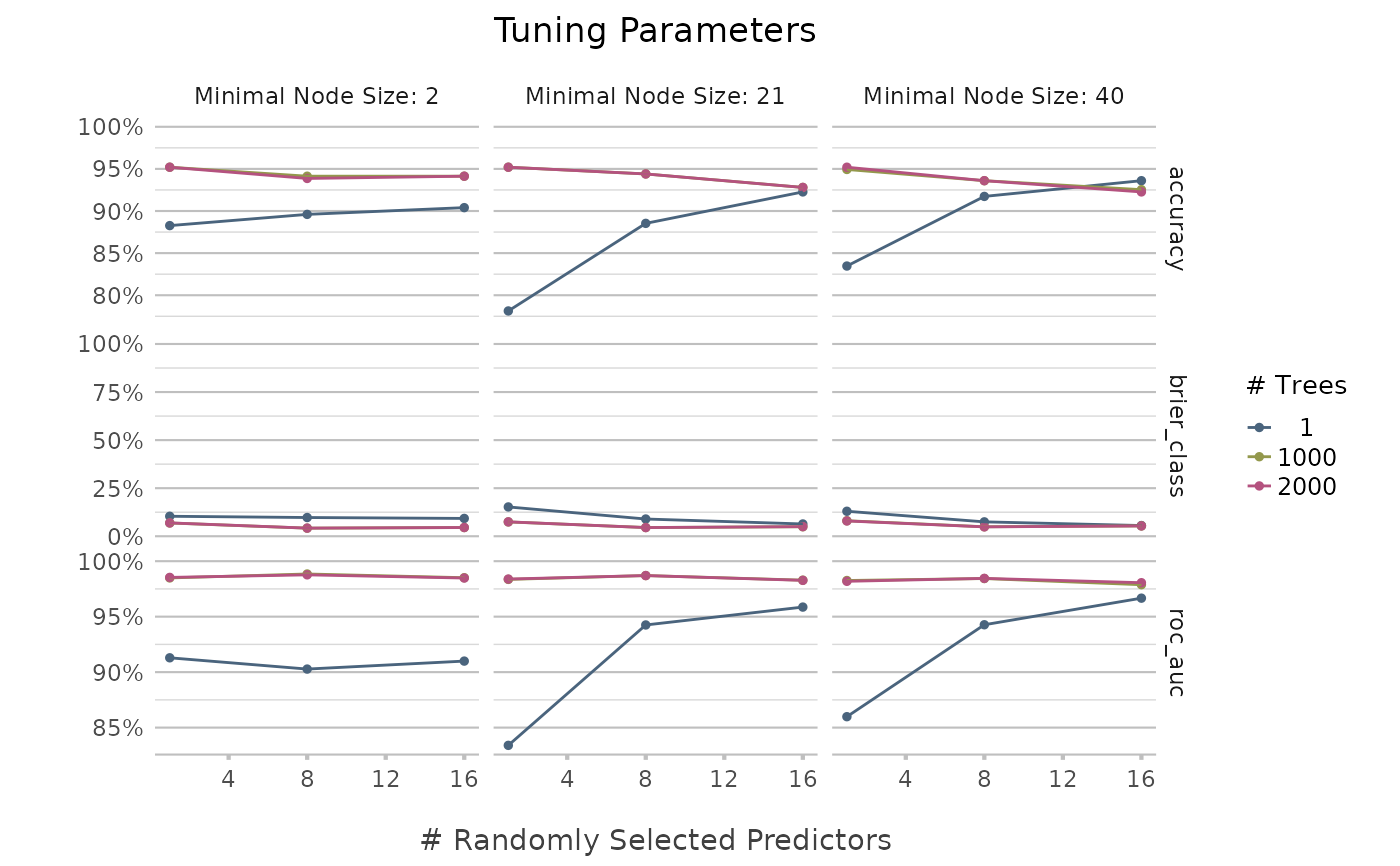 # predict ESBL test outcome based on MICs using 2 different models
model1 <- esbl_tests |> ml_xg_boost(esbl, where(is.double))
model2 <- esbl_tests |> ml_decision_trees(esbl, where(is.double))
# Assessing A Model ----------------------------------------------------
model1 |> get_metrics()
#> .metric .estimator .estimate
#> 1 accuracy binary 0.9040000
#> 2 kap binary 0.8069995
model2 |> get_metrics()
#> .metric .estimator .estimate
#> 1 accuracy binary 0.9200000
#> 2 kap binary 0.8380409
model1 |> confusion_matrix()
#>
#> ── Confusion Matrix ────────────────────────────────────────────────────────────
#>
#> TRUE FALSE
#> TRUE 61 6
#> FALSE 6 52
#>
#>
#> ── Model Metrics ───────────────────────────────────────────────────────────────
#>
#> Accuracy 0.904
#> Area under the Precision Recall Curve (APRC) 0.979
#> Area under the Receiver Operator Curve (AROC) 0.966
#> Balanced Accuracy 0.903
#> Brier Score for Classification Models (BSCM) 0.062
#> Concordance Correlation Coefficient (CCC) -0.298
#> Costs Function for Poor Classification (CFPC) 0.102
#> F Measure 0.910
#> Gain Capture 0.933
#> Huber Loss 0.669
#> Index of Ideality of Correlation (IIC) NaN
#> J-Index 0.807
#> Kappa 0.807
#> Matthews Correlation Coefficient (MCC) 0.807
#> Mean Absolute Error (MAE) 0.938
#> Mean Absolute Percent Error (MAPE) 49.706
#> Mean Absolute Scaled Error (MASE) 116.320
#> Mean log Loss for Multinomial Data (MLMD) 0.230
#> Mean log Loss for Poisson Data (MLPD) 4.307
#> Mean Percentage Error (MPE) 49.706
#> Mean Signed Deviation (MSD) 0.938
#> Negative Predictive Value (NPV) 0.897
#> Positive Predictive Value (PPV) 0.910
#> Precision 0.910
#> Prevalence 0.536
#> Psuedo-Huber Loss (PHL) 0.550
#> R Squared 0.752
#> R Squared - Traditional (RST) -5.974
#> Ratio of Performance to Deviation (RPD) 0.380
#> Ratio of Performance to Inter-Quartile (RPIQ) 0.759
#> Recall 0.910
#> Root Mean Squared Error (RMSE) 1.317
#> Sensitivity 0.910
#> Specificity 0.897
#> Symmetric Mean Absolute Percentage Error (SMAPE) 94.508
# a correlation plot of a model shows the training data
model1 |> correlation_plot(add_values = FALSE)
# predict ESBL test outcome based on MICs using 2 different models
model1 <- esbl_tests |> ml_xg_boost(esbl, where(is.double))
model2 <- esbl_tests |> ml_decision_trees(esbl, where(is.double))
# Assessing A Model ----------------------------------------------------
model1 |> get_metrics()
#> .metric .estimator .estimate
#> 1 accuracy binary 0.9040000
#> 2 kap binary 0.8069995
model2 |> get_metrics()
#> .metric .estimator .estimate
#> 1 accuracy binary 0.9200000
#> 2 kap binary 0.8380409
model1 |> confusion_matrix()
#>
#> ── Confusion Matrix ────────────────────────────────────────────────────────────
#>
#> TRUE FALSE
#> TRUE 61 6
#> FALSE 6 52
#>
#>
#> ── Model Metrics ───────────────────────────────────────────────────────────────
#>
#> Accuracy 0.904
#> Area under the Precision Recall Curve (APRC) 0.979
#> Area under the Receiver Operator Curve (AROC) 0.966
#> Balanced Accuracy 0.903
#> Brier Score for Classification Models (BSCM) 0.062
#> Concordance Correlation Coefficient (CCC) -0.298
#> Costs Function for Poor Classification (CFPC) 0.102
#> F Measure 0.910
#> Gain Capture 0.933
#> Huber Loss 0.669
#> Index of Ideality of Correlation (IIC) NaN
#> J-Index 0.807
#> Kappa 0.807
#> Matthews Correlation Coefficient (MCC) 0.807
#> Mean Absolute Error (MAE) 0.938
#> Mean Absolute Percent Error (MAPE) 49.706
#> Mean Absolute Scaled Error (MASE) 116.320
#> Mean log Loss for Multinomial Data (MLMD) 0.230
#> Mean log Loss for Poisson Data (MLPD) 4.307
#> Mean Percentage Error (MPE) 49.706
#> Mean Signed Deviation (MSD) 0.938
#> Negative Predictive Value (NPV) 0.897
#> Positive Predictive Value (PPV) 0.910
#> Precision 0.910
#> Prevalence 0.536
#> Psuedo-Huber Loss (PHL) 0.550
#> R Squared 0.752
#> R Squared - Traditional (RST) -5.974
#> Ratio of Performance to Deviation (RPD) 0.380
#> Ratio of Performance to Inter-Quartile (RPIQ) 0.759
#> Recall 0.910
#> Root Mean Squared Error (RMSE) 1.317
#> Sensitivity 0.910
#> Specificity 0.897
#> Symmetric Mean Absolute Percentage Error (SMAPE) 94.508
# a correlation plot of a model shows the training data
model1 |> correlation_plot(add_values = FALSE)
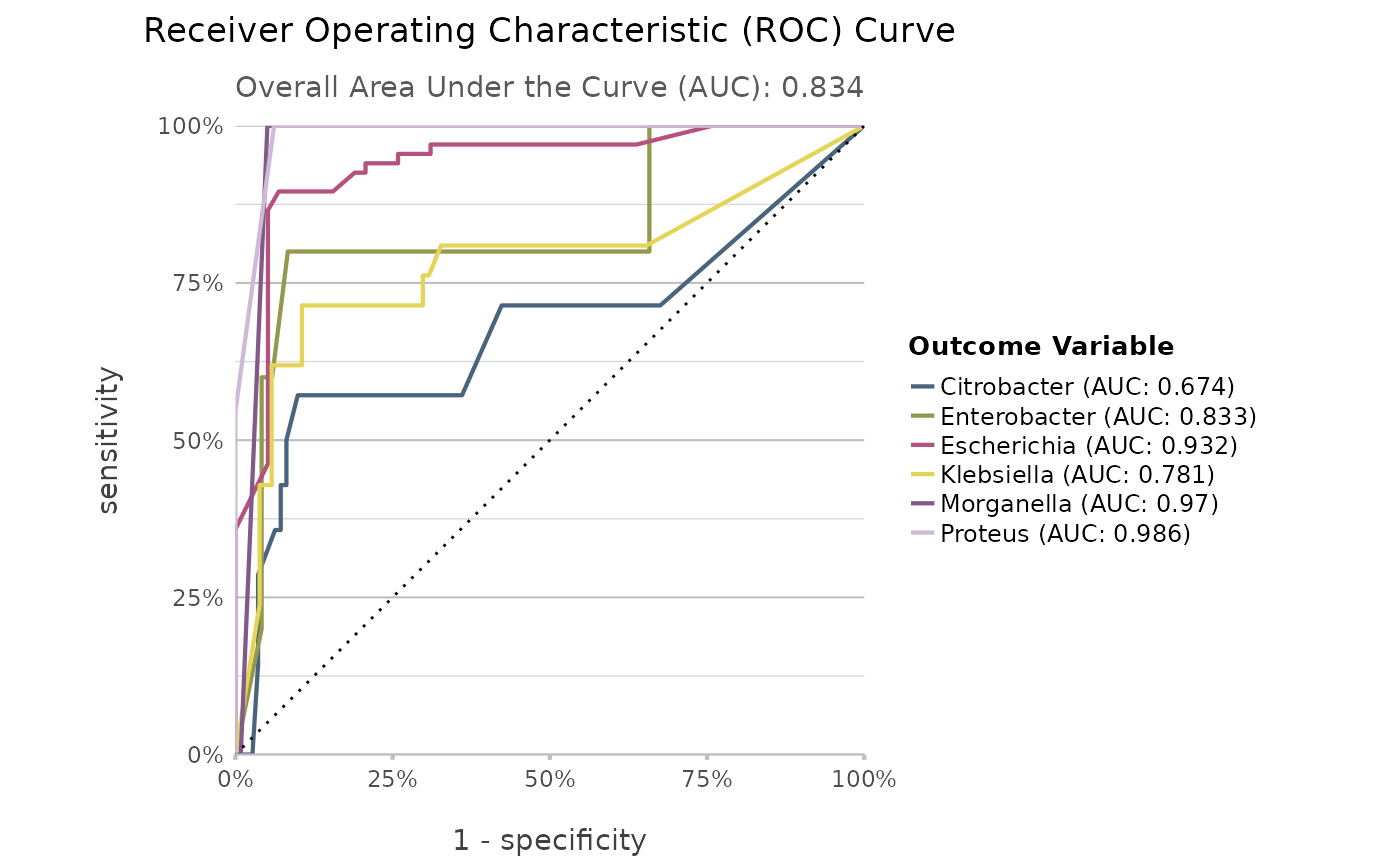 model1 |> feature_importances()
#> # A tibble: 13 × 5
#> feature gain cover frequency importance
#> * <chr> <dbl> <dbl> <dbl> <dbl>
#> 1 CTX 0.647 0.374 0.175 0.498
#> 2 FOX 0.135 0.154 0.131 0.138
#> 3 GEN 0.0672 0.111 0.0562 0.0738
#> 4 TZP 0.0176 0.143 0.138 0.0667
#> 5 CIP 0.0525 0.0471 0.112 0.0634
#> 6 CAZ 0.0257 0.0417 0.15 0.0538
#> 7 IPM 0.0159 0.0565 0.0375 0.0283
#> 8 TMP 0.0128 0.0192 0.05 0.0215
#> 9 FOS 0.00965 0.0120 0.0562 0.0194
#> 10 NIT 0.00894 0.0161 0.05 0.0186
#> 11 CXM 0.00509 0.0166 0.025 0.0114
#> 12 AMC 0.00205 0.00343 0.0125 0.00442
#> 13 TOB 0.0000258 0.00455 0.00625 0.00218
model1 |> feature_importances() |> autoplot()
model1 |> feature_importances()
#> # A tibble: 13 × 5
#> feature gain cover frequency importance
#> * <chr> <dbl> <dbl> <dbl> <dbl>
#> 1 CTX 0.647 0.374 0.175 0.498
#> 2 FOX 0.135 0.154 0.131 0.138
#> 3 GEN 0.0672 0.111 0.0562 0.0738
#> 4 TZP 0.0176 0.143 0.138 0.0667
#> 5 CIP 0.0525 0.0471 0.112 0.0634
#> 6 CAZ 0.0257 0.0417 0.15 0.0538
#> 7 IPM 0.0159 0.0565 0.0375 0.0283
#> 8 TMP 0.0128 0.0192 0.05 0.0215
#> 9 FOS 0.00965 0.0120 0.0562 0.0194
#> 10 NIT 0.00894 0.0161 0.05 0.0186
#> 11 CXM 0.00509 0.0166 0.025 0.0114
#> 12 AMC 0.00205 0.00343 0.0125 0.00442
#> 13 TOB 0.0000258 0.00455 0.00625 0.00218
model1 |> feature_importances() |> autoplot()
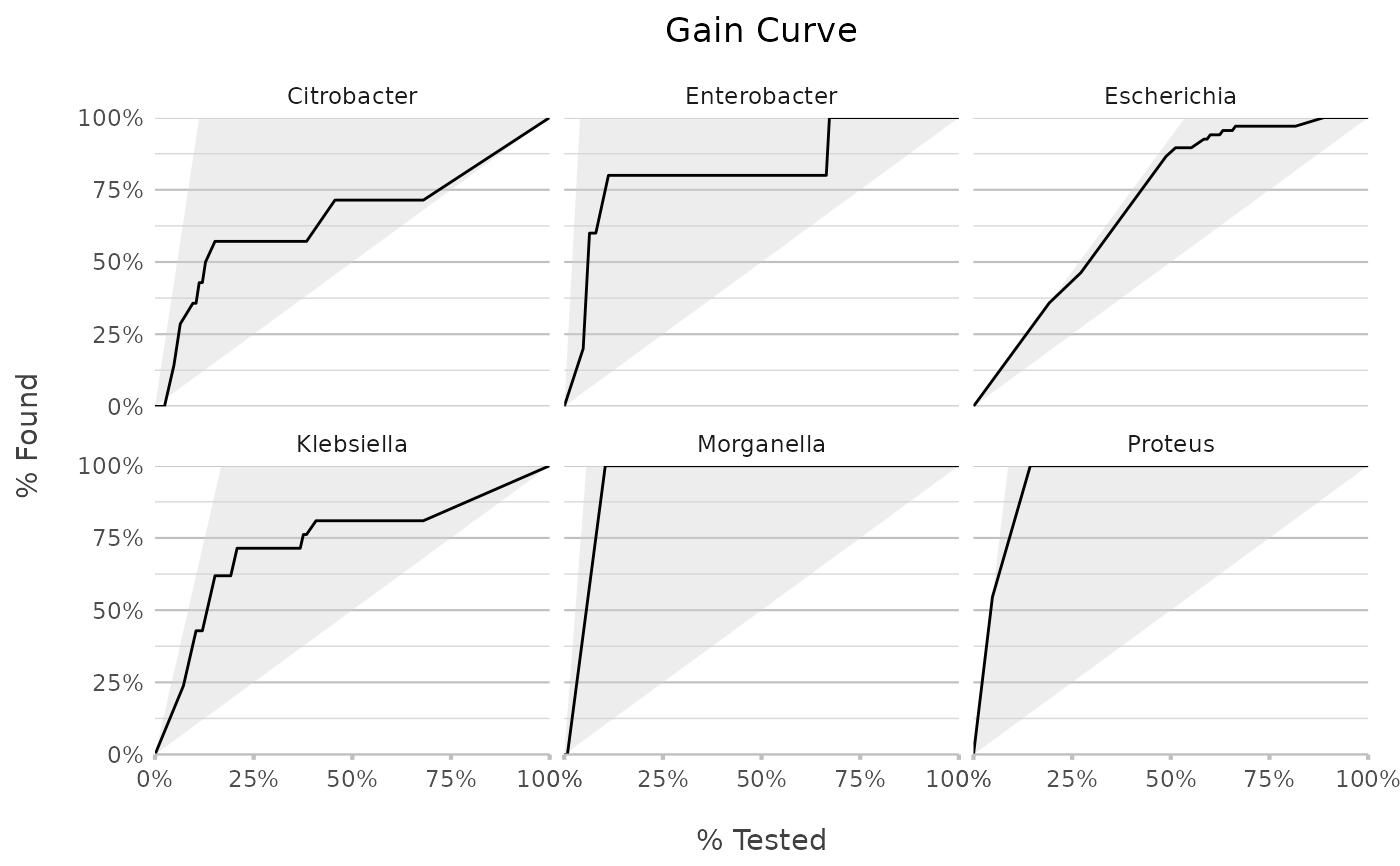 model2 |> feature_importance_plot()
model2 |> feature_importance_plot()
 # decision trees can also have a tree plot
model2 |> tree_plot()
# decision trees can also have a tree plot
model2 |> tree_plot()
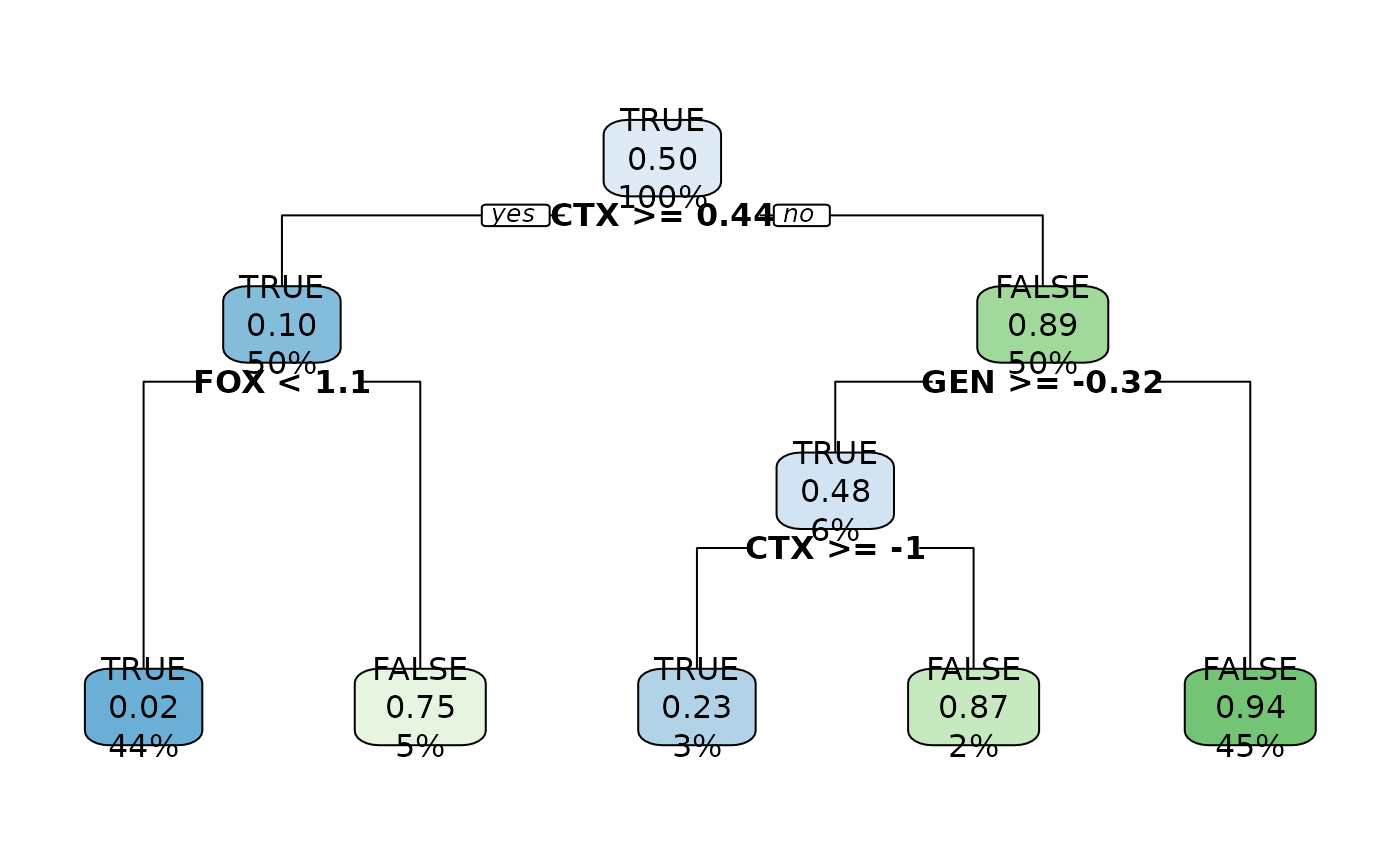 # Applying A Model -----------------------------------------------------
# simply use base R `predict()` to apply a model:
model1 |> predict(esbl_tests)
#> # A tibble: 500 × 1
#> predicted
#> <lgl>
#> 1 FALSE
#> 2 FALSE
#> 3 FALSE
#> 4 FALSE
#> 5 FALSE
#> 6 FALSE
#> 7 FALSE
#> 8 FALSE
#> 9 FALSE
#> 10 FALSE
#> # ℹ 490 more rows
# but apply_model_to() contains more info and can apply corrections:
model1 |> apply_model_to(esbl_tests)
#> # A tibble: 500 × 4
#> predicted certainty .pred_TRUE .pred_FALSE
#> * <lgl> <dbl> <dbl> <dbl>
#> 1 FALSE 0.984 0.0158 0.984
#> 2 FALSE 0.982 0.0180 0.982
#> 3 FALSE 0.824 0.176 0.824
#> 4 FALSE 0.984 0.0163 0.984
#> 5 FALSE 0.989 0.0109 0.989
#> 6 FALSE 0.947 0.0528 0.947
#> 7 FALSE 0.978 0.0221 0.978
#> 8 FALSE 0.990 0.0102 0.990
#> 9 FALSE 0.978 0.0221 0.978
#> 10 FALSE 0.984 0.0160 0.984
#> # ℹ 490 more rows
# and to format the result, e.g. for an API:
model1 |> apply_model_to(esbl_tests) |> dplyr::slice(1:10) |> format()
#> [1] "FALSE (98.4%)" "FALSE (98.2%)" "FALSE (82.4%)" "FALSE (98.4%)"
#> [5] "FALSE (98.9%)" "FALSE (94.7%)" "FALSE (97.8%)" "FALSE (99%)"
#> [9] "FALSE (97.8%)" "FALSE (98.4%)"
# put in only parts of new data:
model1 |> apply_model_to(esbl_tests[, 1:15])
#> Missing variables in the data: CIP, IPM, MEM, COL, though XGBoost can function nonetheless
#> # A tibble: 500 × 4
#> predicted certainty .pred_TRUE .pred_FALSE
#> * <lgl> <dbl> <dbl> <dbl>
#> 1 FALSE 0.984 0.0158 0.984
#> 2 FALSE 0.982 0.0180 0.982
#> 3 FALSE 0.824 0.176 0.824
#> 4 FALSE 0.984 0.0163 0.984
#> 5 FALSE 0.989 0.0109 0.989
#> 6 FALSE 0.947 0.0528 0.947
#> 7 FALSE 0.978 0.0221 0.978
#> 8 FALSE 0.990 0.0102 0.990
#> 9 FALSE 0.978 0.0221 0.978
#> 10 FALSE 0.986 0.0137 0.986
#> # ℹ 490 more rows
esbl_tests2 <- esbl_tests
esbl_tests2[2, "CIP"] <- NA
esbl_tests2[5, "AMC"] <- NA
# with XGBoost, nothing will be changed (it can correct for missings):
model1 |> apply_model_to(esbl_tests2)
#> # A tibble: 500 × 4
#> predicted certainty .pred_TRUE .pred_FALSE
#> * <lgl> <dbl> <dbl> <dbl>
#> 1 FALSE 0.984 0.0158 0.984
#> 2 FALSE 0.982 0.0180 0.982
#> 3 FALSE 0.824 0.176 0.824
#> 4 FALSE 0.984 0.0163 0.984
#> 5 FALSE 0.989 0.0109 0.989
#> 6 FALSE 0.947 0.0528 0.947
#> 7 FALSE 0.978 0.0221 0.978
#> 8 FALSE 0.990 0.0102 0.990
#> 9 FALSE 0.978 0.0221 0.978
#> 10 FALSE 0.984 0.0160 0.984
#> # ℹ 490 more rows
# with random forest (or others), missings will be imputed:
model2 |> apply_model_to(esbl_tests2)
#> Generating MICE using m = 5 multiple imputations...
#> OK.
#> Imputed variable 'AMC' using MICE (method: predictive mean matching) in row 5
#> Imputed variable 'CIP' using MICE (method: predictive mean matching) in row 2
#> # A tibble: 500 × 4
#> predicted certainty .pred_TRUE .pred_FALSE
#> * <lgl> <dbl> <dbl> <dbl>
#> 1 FALSE 0.888 0.112 0.888
#> 2 FALSE 0.888 0.112 0.888
#> 3 FALSE 0.888 0.112 0.888
#> 4 FALSE 0.888 0.112 0.888
#> 5 FALSE 0.888 0.112 0.888
#> 6 FALSE 0.737 0.263 0.737
#> 7 FALSE 0.888 0.112 0.888
#> 8 FALSE 0.888 0.112 0.888
#> 9 FALSE 0.888 0.112 0.888
#> 10 FALSE 0.888 0.112 0.888
#> # ℹ 490 more rows
# Tuning A Model -------------------------------------------------------
# tune the parameters of a model (will take some time)
tuning <- model2 |>
tune_parameters(k = 5, levels = 3)
#> Assuming tuning analysis for the 3 parameters 'cost_complexity', 'tree_depth', 'min_n'.
#> Use e.g. `cost_complexity = dials::cost_complexity()` to specify tuning for less parameters.
#>
#> These parameters will be tuned with these values:
#> - cost_complexity: 0.000000000100, 0.000003162278, 0.100000000000
#> - tree_depth: 1, 8, 15
#> - min_n: 2, 21, 40
#> [2025-11-26 15:05:16] Running tuning analysis using a 5-fold cross-validation for 27 combinations...
#> [2025-11-26 15:05:27] Done.
autoplot(tuning)
# Applying A Model -----------------------------------------------------
# simply use base R `predict()` to apply a model:
model1 |> predict(esbl_tests)
#> # A tibble: 500 × 1
#> predicted
#> <lgl>
#> 1 FALSE
#> 2 FALSE
#> 3 FALSE
#> 4 FALSE
#> 5 FALSE
#> 6 FALSE
#> 7 FALSE
#> 8 FALSE
#> 9 FALSE
#> 10 FALSE
#> # ℹ 490 more rows
# but apply_model_to() contains more info and can apply corrections:
model1 |> apply_model_to(esbl_tests)
#> # A tibble: 500 × 4
#> predicted certainty .pred_TRUE .pred_FALSE
#> * <lgl> <dbl> <dbl> <dbl>
#> 1 FALSE 0.984 0.0158 0.984
#> 2 FALSE 0.982 0.0180 0.982
#> 3 FALSE 0.824 0.176 0.824
#> 4 FALSE 0.984 0.0163 0.984
#> 5 FALSE 0.989 0.0109 0.989
#> 6 FALSE 0.947 0.0528 0.947
#> 7 FALSE 0.978 0.0221 0.978
#> 8 FALSE 0.990 0.0102 0.990
#> 9 FALSE 0.978 0.0221 0.978
#> 10 FALSE 0.984 0.0160 0.984
#> # ℹ 490 more rows
# and to format the result, e.g. for an API:
model1 |> apply_model_to(esbl_tests) |> dplyr::slice(1:10) |> format()
#> [1] "FALSE (98.4%)" "FALSE (98.2%)" "FALSE (82.4%)" "FALSE (98.4%)"
#> [5] "FALSE (98.9%)" "FALSE (94.7%)" "FALSE (97.8%)" "FALSE (99%)"
#> [9] "FALSE (97.8%)" "FALSE (98.4%)"
# put in only parts of new data:
model1 |> apply_model_to(esbl_tests[, 1:15])
#> Missing variables in the data: CIP, IPM, MEM, COL, though XGBoost can function nonetheless
#> # A tibble: 500 × 4
#> predicted certainty .pred_TRUE .pred_FALSE
#> * <lgl> <dbl> <dbl> <dbl>
#> 1 FALSE 0.984 0.0158 0.984
#> 2 FALSE 0.982 0.0180 0.982
#> 3 FALSE 0.824 0.176 0.824
#> 4 FALSE 0.984 0.0163 0.984
#> 5 FALSE 0.989 0.0109 0.989
#> 6 FALSE 0.947 0.0528 0.947
#> 7 FALSE 0.978 0.0221 0.978
#> 8 FALSE 0.990 0.0102 0.990
#> 9 FALSE 0.978 0.0221 0.978
#> 10 FALSE 0.986 0.0137 0.986
#> # ℹ 490 more rows
esbl_tests2 <- esbl_tests
esbl_tests2[2, "CIP"] <- NA
esbl_tests2[5, "AMC"] <- NA
# with XGBoost, nothing will be changed (it can correct for missings):
model1 |> apply_model_to(esbl_tests2)
#> # A tibble: 500 × 4
#> predicted certainty .pred_TRUE .pred_FALSE
#> * <lgl> <dbl> <dbl> <dbl>
#> 1 FALSE 0.984 0.0158 0.984
#> 2 FALSE 0.982 0.0180 0.982
#> 3 FALSE 0.824 0.176 0.824
#> 4 FALSE 0.984 0.0163 0.984
#> 5 FALSE 0.989 0.0109 0.989
#> 6 FALSE 0.947 0.0528 0.947
#> 7 FALSE 0.978 0.0221 0.978
#> 8 FALSE 0.990 0.0102 0.990
#> 9 FALSE 0.978 0.0221 0.978
#> 10 FALSE 0.984 0.0160 0.984
#> # ℹ 490 more rows
# with random forest (or others), missings will be imputed:
model2 |> apply_model_to(esbl_tests2)
#> Generating MICE using m = 5 multiple imputations...
#> OK.
#> Imputed variable 'AMC' using MICE (method: predictive mean matching) in row 5
#> Imputed variable 'CIP' using MICE (method: predictive mean matching) in row 2
#> # A tibble: 500 × 4
#> predicted certainty .pred_TRUE .pred_FALSE
#> * <lgl> <dbl> <dbl> <dbl>
#> 1 FALSE 0.888 0.112 0.888
#> 2 FALSE 0.888 0.112 0.888
#> 3 FALSE 0.888 0.112 0.888
#> 4 FALSE 0.888 0.112 0.888
#> 5 FALSE 0.888 0.112 0.888
#> 6 FALSE 0.737 0.263 0.737
#> 7 FALSE 0.888 0.112 0.888
#> 8 FALSE 0.888 0.112 0.888
#> 9 FALSE 0.888 0.112 0.888
#> 10 FALSE 0.888 0.112 0.888
#> # ℹ 490 more rows
# Tuning A Model -------------------------------------------------------
# tune the parameters of a model (will take some time)
tuning <- model2 |>
tune_parameters(k = 5, levels = 3)
#> Assuming tuning analysis for the 3 parameters 'cost_complexity', 'tree_depth', 'min_n'.
#> Use e.g. `cost_complexity = dials::cost_complexity()` to specify tuning for less parameters.
#>
#> These parameters will be tuned with these values:
#> - cost_complexity: 0.000000000100, 0.000003162278, 0.100000000000
#> - tree_depth: 1, 8, 15
#> - min_n: 2, 21, 40
#> [2025-11-26 15:05:16] Running tuning analysis using a 5-fold cross-validation for 27 combinations...
#> [2025-11-26 15:05:27] Done.
autoplot(tuning)
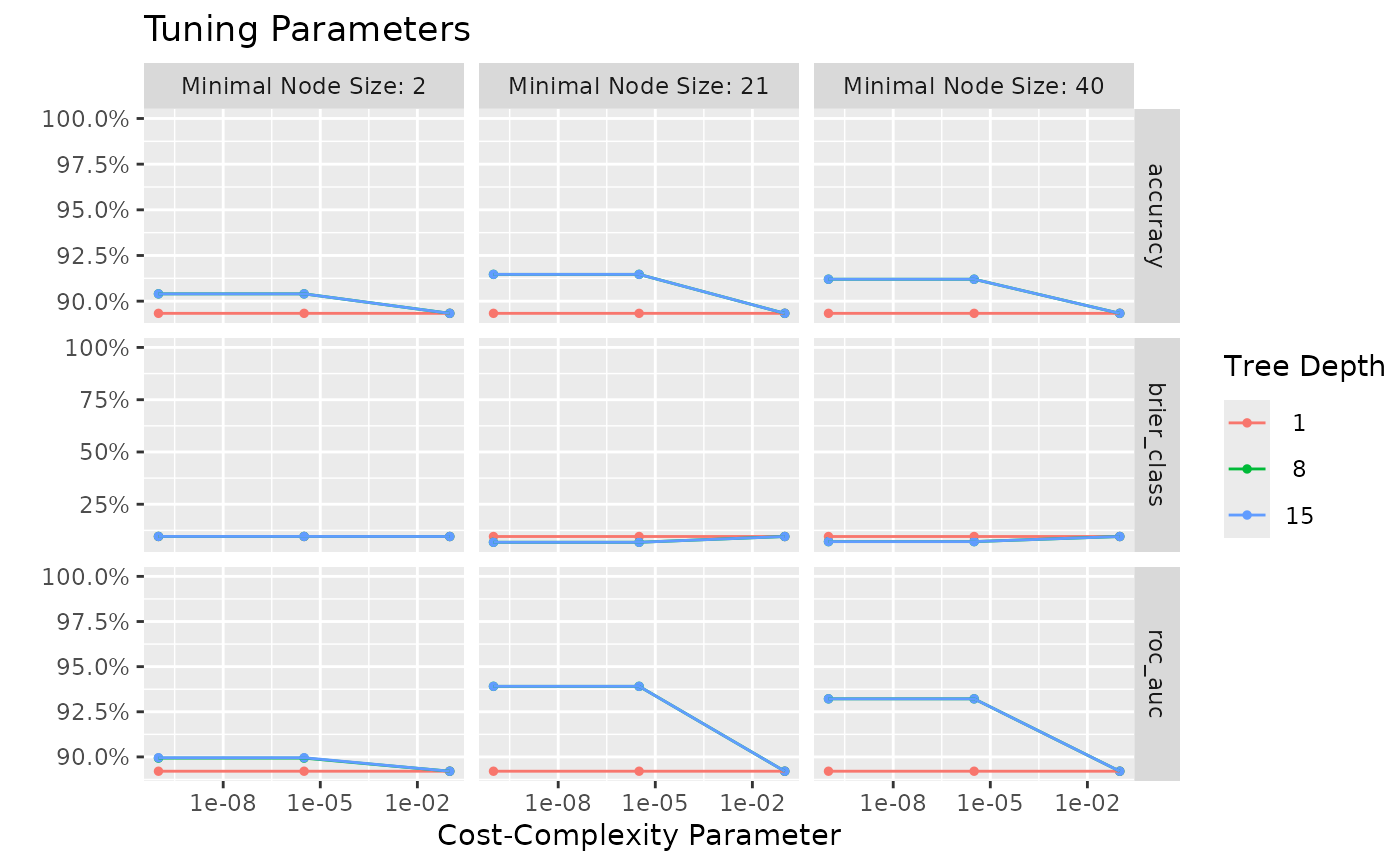 # tuning analysis by specifying (some) parameters
iris |>
ml_xg_boost(Species) |>
tune_parameters(mtry = dials::mtry(range = c(1, 3)),
trees = dials::trees())
#>
#> These parameters will be tuned with these values:
#> - mtry: 1, 2, 3
#> - trees: 1, 500, 1000, 1500, 2000
#> [2025-11-26 15:05:28] Running tuning analysis using a 10-fold cross-validation for 15 combinations...
#> → A | warning: ✖ No observations were detected in `truth` for level: virginica.
#> ℹ Computation will proceed by ignoring those levels.
#> There were issues with some computations A: x15
#> There were issues with some computations A: x15
#>
#> [2025-11-26 15:05:55] Done.
#> # A tibble: 15 × 10
#> mtry trees n .config accuracy brier_class roc_auc accuracy_se
#> * <int> <int> <int> <chr> <dbl> <dbl> <dbl> <dbl>
#> 1 2 1 10 pre0_mod06_post0 0.964 0.219 0.989 0.0199
#> 2 3 1 10 pre0_mod11_post0 0.955 0.213 0.987 0.0202
#> 3 1 1 10 pre0_mod01_post0 0.939 0.236 0.977 0.0288
#> 4 2 1000 10 pre0_mod08_post0 0.938 0.0570 0.990 0.0235
#> 5 2 1500 10 pre0_mod09_post0 0.938 0.0576 0.990 0.0235
#> 6 2 2000 10 pre0_mod10_post0 0.938 0.0579 0.990 0.0235
#> 7 3 500 10 pre0_mod12_post0 0.938 0.0532 0.988 0.0235
#> 8 3 1000 10 pre0_mod13_post0 0.938 0.0549 0.988 0.0235
#> 9 3 1500 10 pre0_mod14_post0 0.938 0.0554 0.988 0.0235
#> 10 3 2000 10 pre0_mod15_post0 0.938 0.0557 0.988 0.0235
#> 11 2 500 10 pre0_mod07_post0 0.938 0.0558 0.988 0.0235
#> 12 1 1500 10 pre0_mod04_post0 0.930 0.0642 0.986 0.0257
#> 13 1 2000 10 pre0_mod05_post0 0.930 0.0654 0.986 0.0257
#> 14 1 500 10 pre0_mod02_post0 0.930 0.0597 0.985 0.0257
#> 15 1 1000 10 pre0_mod03_post0 0.930 0.0626 0.985 0.0257
#> # ℹ 2 more variables: brier_class_se <dbl>, roc_auc_se <dbl>
# Practical Example #1 --------------------------------------------------
# this is what iris data set looks like:
head(iris)
#> Sepal.Length Sepal.Width Petal.Length Petal.Width Species
#> 1 5.1 3.5 1.4 0.2 setosa
#> 2 4.9 3.0 1.4 0.2 setosa
#> 3 4.7 3.2 1.3 0.2 setosa
#> 4 4.6 3.1 1.5 0.2 setosa
#> 5 5.0 3.6 1.4 0.2 setosa
#> 6 5.4 3.9 1.7 0.4 setosa
# create a model to predict the species:
iris_model <- iris |> ml_xg_boost(Species)
iris_model_rf <- iris |> ml_random_forest(Species)
# is it a bit reliable?
get_metrics(iris_model)
#> .metric .estimator .estimate
#> 1 accuracy multiclass 0.9210526
#> 2 kap multiclass 0.8814969
# now try to predict species from an arbitrary data set:
to_predict <- data.frame(Sepal.Length = 5,
Sepal.Width = 3,
Petal.Length = 1.5,
Petal.Width = 0.5)
to_predict
#> Sepal.Length Sepal.Width Petal.Length Petal.Width
#> 1 5 3 1.5 0.5
# should be 'setosa' in the 'predicted' column with huge certainty:
iris_model |> apply_model_to(to_predict)
#> # A tibble: 1 × 5
#> predicted certainty .pred_setosa .pred_versicolor .pred_virginica
#> * <fct> <dbl> <dbl> <dbl> <dbl>
#> 1 setosa 0.981 0.981 0.0103 0.00846
# API formatting:
iris_model |> apply_model_to(to_predict) |> format()
#> [1] "setosa (98.1%; versicolor = 1%, virginica = 0.8%)"
iris_model |> apply_model_to(to_predict, only_prediction = TRUE)
#> [1] setosa
#> Levels: setosa versicolor virginica
iris_model |> apply_model_to(to_predict, only_certainty = TRUE)
#> [1] 0.9812005
# which variables are generally important (only trained variables)?
iris_model |> feature_importances()
#> # A tibble: 3 × 5
#> feature gain cover frequency importance
#> * <chr> <dbl> <dbl> <dbl> <dbl>
#> 1 Petal.Width 0.956 0.761 0.590 0.844
#> 2 Sepal.Width 0.0295 0.144 0.247 0.0958
#> 3 Sepal.Length 0.0147 0.0954 0.163 0.0604
# how would the model do without the 'Sepal.Length' column?
to_predict <- to_predict[, c("Sepal.Width", "Petal.Width", "Petal.Length")]
to_predict
#> Sepal.Width Petal.Width Petal.Length
#> 1 3 0.5 1.5
iris_model |> apply_model_to(to_predict)
#> Missing variables in the data: Sepal.Length, though XGBoost can function nonetheless
#> # A tibble: 1 × 5
#> predicted certainty .pred_setosa .pred_versicolor .pred_virginica
#> * <fct> <dbl> <dbl> <dbl> <dbl>
#> 1 setosa 0.981 0.981 0.0103 0.00846
# now compare that with a random forest model that requires imputation:
iris_model_rf |> apply_model_to(to_predict)
#> Adding missing variable as median: Sepal.Length
#> # A tibble: 1 × 5
#> predicted certainty .pred_setosa .pred_versicolor .pred_virginica
#> * <fct> <dbl> <dbl> <dbl> <dbl>
#> 1 setosa 0.534 0.534 0.432 0.0348
# the certainly is very different.
# Practical Example #2 -------------------------------------------------
# this example shows plotting methods for a model
# train model to predict genus based on MICs:
genus <- esbl_tests |> ml_xg_boost(genus, everything())
genus |> get_metrics()
#> .metric .estimator .estimate
#> 1 accuracy multiclass 0.8800000
#> 2 kap multiclass 0.7890177
genus |> feature_importance_plot()
# tuning analysis by specifying (some) parameters
iris |>
ml_xg_boost(Species) |>
tune_parameters(mtry = dials::mtry(range = c(1, 3)),
trees = dials::trees())
#>
#> These parameters will be tuned with these values:
#> - mtry: 1, 2, 3
#> - trees: 1, 500, 1000, 1500, 2000
#> [2025-11-26 15:05:28] Running tuning analysis using a 10-fold cross-validation for 15 combinations...
#> → A | warning: ✖ No observations were detected in `truth` for level: virginica.
#> ℹ Computation will proceed by ignoring those levels.
#> There were issues with some computations A: x15
#> There were issues with some computations A: x15
#>
#> [2025-11-26 15:05:55] Done.
#> # A tibble: 15 × 10
#> mtry trees n .config accuracy brier_class roc_auc accuracy_se
#> * <int> <int> <int> <chr> <dbl> <dbl> <dbl> <dbl>
#> 1 2 1 10 pre0_mod06_post0 0.964 0.219 0.989 0.0199
#> 2 3 1 10 pre0_mod11_post0 0.955 0.213 0.987 0.0202
#> 3 1 1 10 pre0_mod01_post0 0.939 0.236 0.977 0.0288
#> 4 2 1000 10 pre0_mod08_post0 0.938 0.0570 0.990 0.0235
#> 5 2 1500 10 pre0_mod09_post0 0.938 0.0576 0.990 0.0235
#> 6 2 2000 10 pre0_mod10_post0 0.938 0.0579 0.990 0.0235
#> 7 3 500 10 pre0_mod12_post0 0.938 0.0532 0.988 0.0235
#> 8 3 1000 10 pre0_mod13_post0 0.938 0.0549 0.988 0.0235
#> 9 3 1500 10 pre0_mod14_post0 0.938 0.0554 0.988 0.0235
#> 10 3 2000 10 pre0_mod15_post0 0.938 0.0557 0.988 0.0235
#> 11 2 500 10 pre0_mod07_post0 0.938 0.0558 0.988 0.0235
#> 12 1 1500 10 pre0_mod04_post0 0.930 0.0642 0.986 0.0257
#> 13 1 2000 10 pre0_mod05_post0 0.930 0.0654 0.986 0.0257
#> 14 1 500 10 pre0_mod02_post0 0.930 0.0597 0.985 0.0257
#> 15 1 1000 10 pre0_mod03_post0 0.930 0.0626 0.985 0.0257
#> # ℹ 2 more variables: brier_class_se <dbl>, roc_auc_se <dbl>
# Practical Example #1 --------------------------------------------------
# this is what iris data set looks like:
head(iris)
#> Sepal.Length Sepal.Width Petal.Length Petal.Width Species
#> 1 5.1 3.5 1.4 0.2 setosa
#> 2 4.9 3.0 1.4 0.2 setosa
#> 3 4.7 3.2 1.3 0.2 setosa
#> 4 4.6 3.1 1.5 0.2 setosa
#> 5 5.0 3.6 1.4 0.2 setosa
#> 6 5.4 3.9 1.7 0.4 setosa
# create a model to predict the species:
iris_model <- iris |> ml_xg_boost(Species)
iris_model_rf <- iris |> ml_random_forest(Species)
# is it a bit reliable?
get_metrics(iris_model)
#> .metric .estimator .estimate
#> 1 accuracy multiclass 0.9210526
#> 2 kap multiclass 0.8814969
# now try to predict species from an arbitrary data set:
to_predict <- data.frame(Sepal.Length = 5,
Sepal.Width = 3,
Petal.Length = 1.5,
Petal.Width = 0.5)
to_predict
#> Sepal.Length Sepal.Width Petal.Length Petal.Width
#> 1 5 3 1.5 0.5
# should be 'setosa' in the 'predicted' column with huge certainty:
iris_model |> apply_model_to(to_predict)
#> # A tibble: 1 × 5
#> predicted certainty .pred_setosa .pred_versicolor .pred_virginica
#> * <fct> <dbl> <dbl> <dbl> <dbl>
#> 1 setosa 0.981 0.981 0.0103 0.00846
# API formatting:
iris_model |> apply_model_to(to_predict) |> format()
#> [1] "setosa (98.1%; versicolor = 1%, virginica = 0.8%)"
iris_model |> apply_model_to(to_predict, only_prediction = TRUE)
#> [1] setosa
#> Levels: setosa versicolor virginica
iris_model |> apply_model_to(to_predict, only_certainty = TRUE)
#> [1] 0.9812005
# which variables are generally important (only trained variables)?
iris_model |> feature_importances()
#> # A tibble: 3 × 5
#> feature gain cover frequency importance
#> * <chr> <dbl> <dbl> <dbl> <dbl>
#> 1 Petal.Width 0.956 0.761 0.590 0.844
#> 2 Sepal.Width 0.0295 0.144 0.247 0.0958
#> 3 Sepal.Length 0.0147 0.0954 0.163 0.0604
# how would the model do without the 'Sepal.Length' column?
to_predict <- to_predict[, c("Sepal.Width", "Petal.Width", "Petal.Length")]
to_predict
#> Sepal.Width Petal.Width Petal.Length
#> 1 3 0.5 1.5
iris_model |> apply_model_to(to_predict)
#> Missing variables in the data: Sepal.Length, though XGBoost can function nonetheless
#> # A tibble: 1 × 5
#> predicted certainty .pred_setosa .pred_versicolor .pred_virginica
#> * <fct> <dbl> <dbl> <dbl> <dbl>
#> 1 setosa 0.981 0.981 0.0103 0.00846
# now compare that with a random forest model that requires imputation:
iris_model_rf |> apply_model_to(to_predict)
#> Adding missing variable as median: Sepal.Length
#> # A tibble: 1 × 5
#> predicted certainty .pred_setosa .pred_versicolor .pred_virginica
#> * <fct> <dbl> <dbl> <dbl> <dbl>
#> 1 setosa 0.534 0.534 0.432 0.0348
# the certainly is very different.
# Practical Example #2 -------------------------------------------------
# this example shows plotting methods for a model
# train model to predict genus based on MICs:
genus <- esbl_tests |> ml_xg_boost(genus, everything())
genus |> get_metrics()
#> .metric .estimator .estimate
#> 1 accuracy multiclass 0.8800000
#> 2 kap multiclass 0.7890177
genus |> feature_importance_plot()
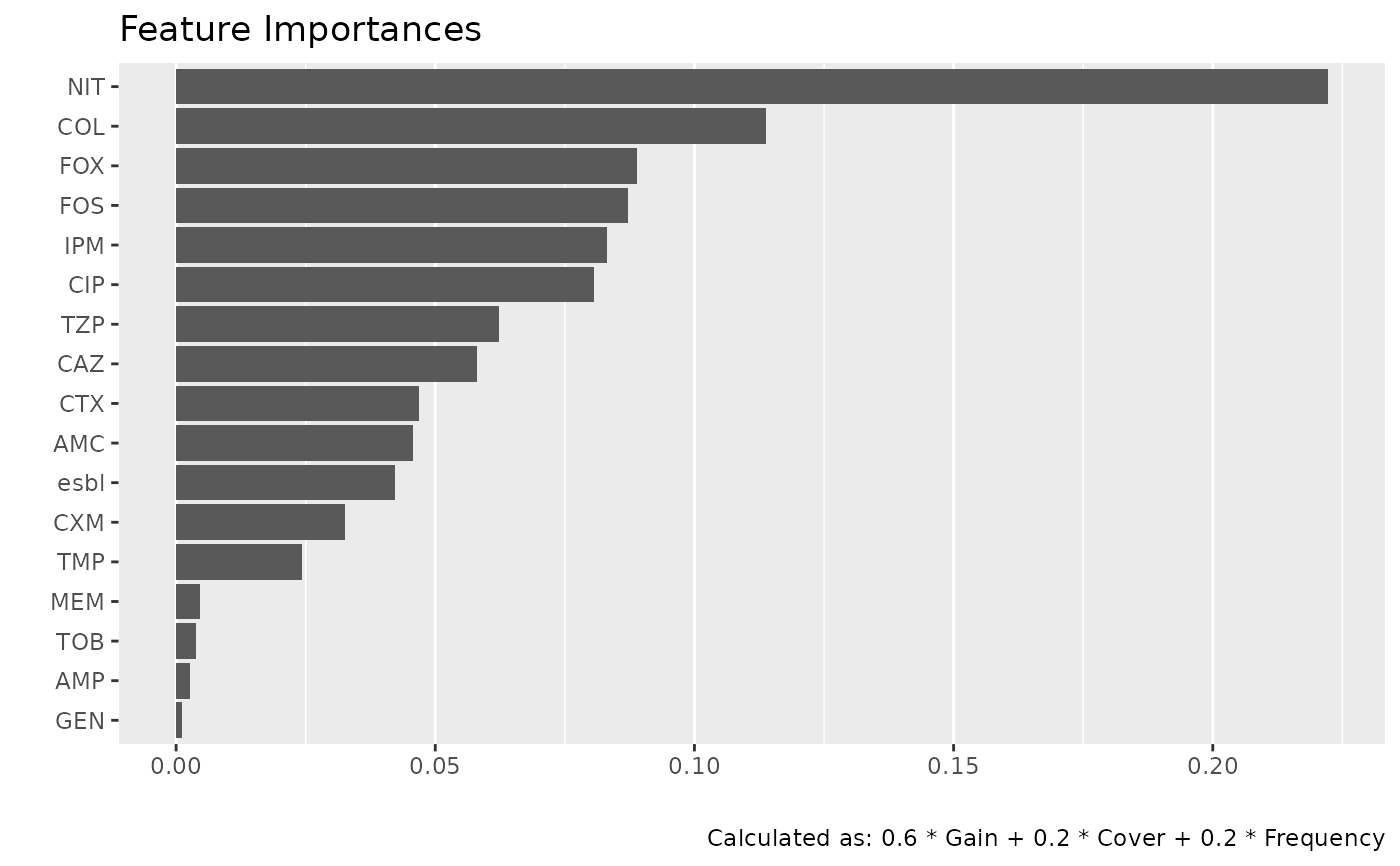 genus |> autoplot()
genus |> autoplot()
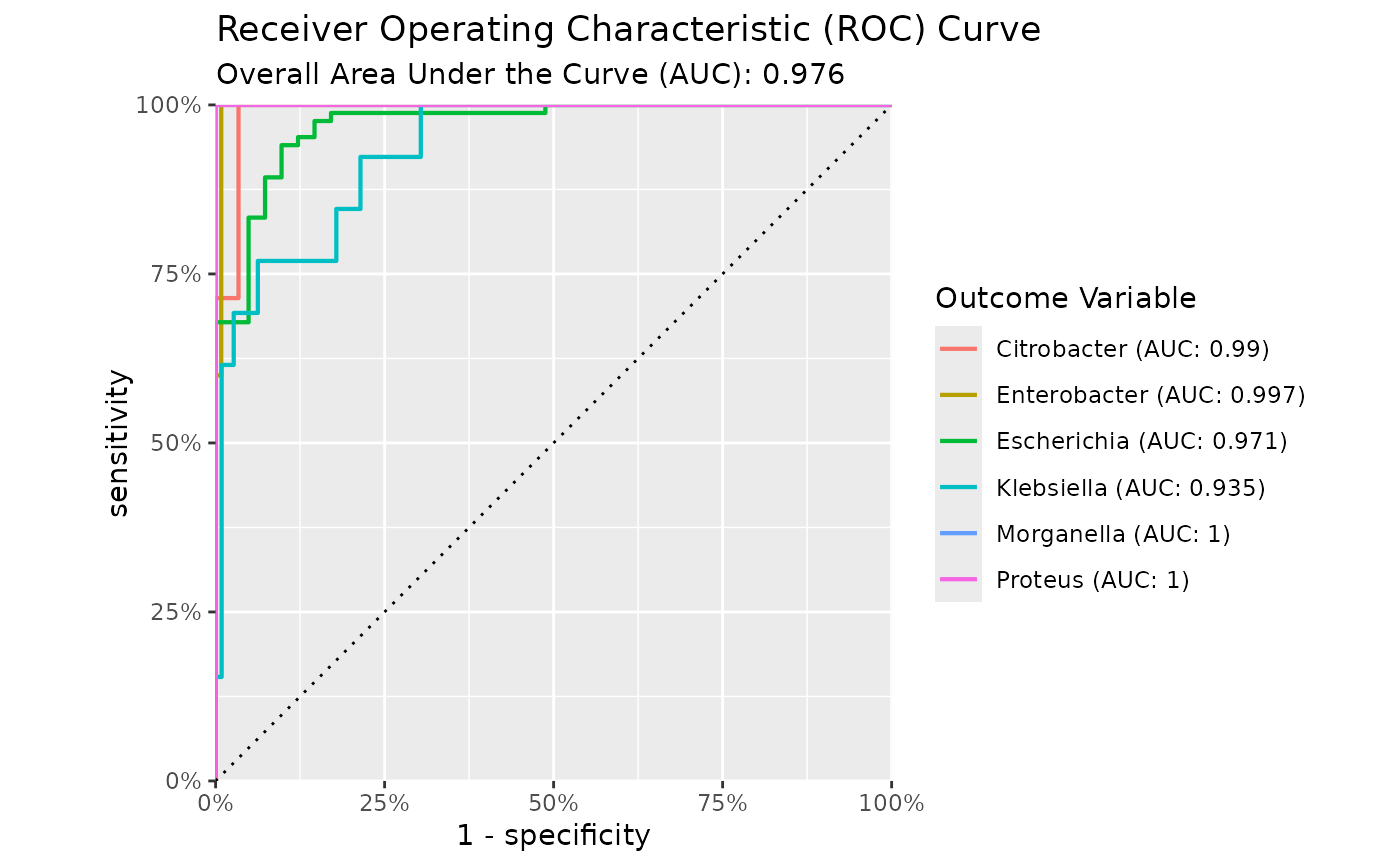 genus |> autoplot(plot_type = "gain")
genus |> autoplot(plot_type = "gain")
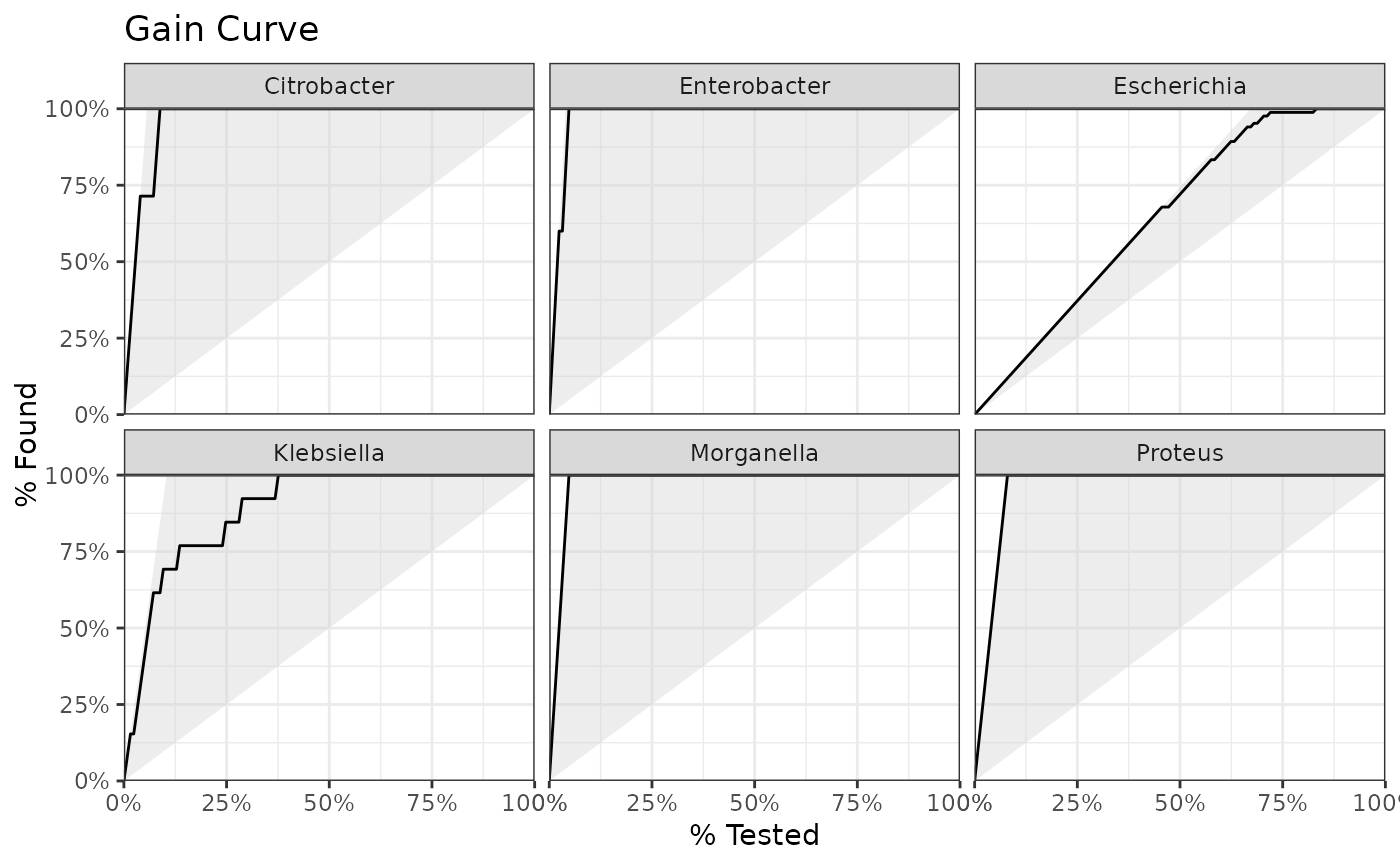 genus |> autoplot(plot_type = "pr")
genus |> autoplot(plot_type = "pr")
